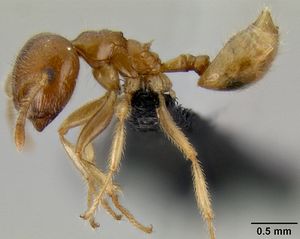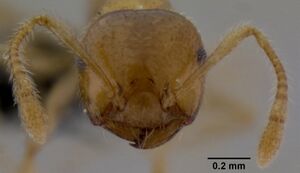Crematogaster volamena
| Crematogaster volamena | |
|---|---|

| |
| Scientific classification | |
| Kingdom: | Animalia |
| Phylum: | Arthropoda |
| Class: | Insecta |
| Order: | Hymenoptera |
| Family: | Formicidae |
| Subfamily: | Myrmicinae |
| Tribe: | Crematogastrini |
| Genus: | Crematogaster |
| Species: | C. volamena |
| Binomial name | |
| Crematogaster volamena Blaimer, 2012 | |
Crematogaster volamena is currently known from about 10 localities along the eastern rainforest belt in Madagascar. Here the species occurs in low- to mid-elevation rainforest or littoral forest. Crematogaster volamena appears to be a generalist in terms of nesting preferences, as it has been collected both nesting arboreally in dead twigs and on the ground in rotten logs. Scant natural history information exists, but noteworthy is a size variation in workers of this species that is reminiscent of a major-minor distinction in other ant genera. The larger workers have a distinctly enlarged head and more powerful mandibles compared to regular workers, and they are more rarely seen throughout collections. These individuals do not share the attributes of the intermediates described here for Crematogaster rasoherinae and Crematogaster madecassa, such as presence of ocelli, or a queen-like modified mesosoma. (Blaimer 2012)
Identification
Blaimer (2012) - A member of the Crematogaster volamena group. Workers of C. volamena are diagnosed most easily by their indistinct occipital carinae, the non-protruding and small eyes and the absence of raised, sharp lateral carinae on the propodeum. All these characteristics are shared with the much rarer, but closely resembling Crematogaster mpanjono, from which it cannot be distinguished reliably based on the worker caste. Crematogaster volamena has slightly longer propodeal spines than C. mpanjono, and the propodeum is lacking longer erect pilosity. The two species are not known to co-occur, and therefore their distributions can help in distinguishing between them. Queens of C. volamena are readily separated from C. mpanjono queens by virtue of their well pronounced occipital carinae and a scuto-scutellar suture that is broadly meeting the mesoscutum. From the remaining Malagasy Orthocrema queens, C. volamena queens are differentiated by the absence of propodeal spines and their large size (HW 1.72, WL 2.61).
Keys including this Species
Distribution
Latitudinal Distribution Pattern
Latitudinal Range: -12.5283° to -24.57055556°.
| North Temperate |
North Subtropical |
Tropical | South Subtropical |
South Temperate |
- Source: AntMaps
Distribution based on Regional Taxon Lists
Malagasy Region: Madagascar (type locality).
Distribution based on AntMaps
Distribution based on AntWeb specimens
Check data from AntWeb
Countries Occupied
| Number of countries occupied by this species based on AntWiki Regional Taxon Lists. In general, fewer countries occupied indicates a narrower range, while more countries indicates a more widespread species. |

|
Estimated Abundance
| Relative abundance based on number of AntMaps records per species (this species within the purple bar). Fewer records (to the left) indicates a less abundant/encountered species while more records (to the right) indicates more abundant/encountered species. |

|
Biology
Castes
Worker
Images from AntWeb
   
| |
| Worker. Specimen code casent0122851. Photographer Bonnie Blaimer, uploaded by Curator Bonnie Blaimer. | Owned by CAS, San Francisco, CA, USA. |
   
| |
| Holotype of Crematogaster volamena. Worker. Specimen code casent0125748. Photographer Bonnie Blaimer, uploaded by Curator Bonnie Blaimer. | Owned by CAS, San Francisco, CA, USA. |
Queen
Images from AntWeb
        
| |
| Queen (alate/dealate). Specimen code casent0161415. Photographer Bonnie Blaimer, uploaded by Curator Bonnie Blaimer. | Owned by CAS, San Francisco, CA, USA. |
Male
Images from AntWeb
    
| |
| Male (alate). Specimen code casent0162852. Photographer Bonnie Blaimer, uploaded by Curator Bonnie Blaimer. | Owned by CAS, San Francisco, CA, USA. |
Nomenclature
The following information is derived from Barry Bolton's Online Catalogue of the Ants of the World.
- volamena. Crematogaster volamena Blaimer, 2012b: 59, figs. 31, 32 (w.q.m.) MADAGASCAR.
- Type-material: holotype worker, 4 paratype workers.
- Type-locality: holotype Madagascar: Prov. Toliara, Forêt Ivohibe, 200 m., 2-4.xii.2006, 24°34.14’S, 47°12.24’E, BLF15448, malaise trap (B.L. Fisher, et al.); paratypes: 1 worker with same data as last but BLF15450, sifted litter (leaf mold/rotten wood) 1 worker Prov. Toamasina, Mont. Anjanaharibe, 18.0 km. 21° NNE Aminantelo, 8-12.iii.2003, 470 m., 15°11.3’S, 49°36.9’E, BLF8006, beating low vegetation, rainforest (B.L. Fisher, et al.), 1 worker Prov. Toamasina, P.N. Mananara-Nord, 225 m., 16°27.3’S, 49°47.25’E, 14.xi.2005, BLF12557, malaise trap, rainforest (B.L. Fisher, et al.), 1 worker Prov. Toamasina, Mont. Akirindro, 7.6 km. 341° NNW Ambinantelo, 600 m., 15°17.3’S, 49°32.9’E, 17-21.iii.2002, BLF8251, beating low vegetation (B.L. Fisher, et al.).
- Type-depositories: CASC (holotype); MCZC, MHNG, SAMC, UCDC (paratypes).
- Combination in C. (Orthocrema): Blaimer, 2012b: 32.
- Distribution: Madagascar.
Unless otherwise noted the text for the remainder of this section is reported from the publication that includes the original description.
Description
Worker
(n=20). Holotype: HW 0.62; HL 0.59; EL 0.11; SL 0.50; WL 0.66; SPL 0.06; PTH 0.13; PTL 0.20; PTW 0.20; PPL 0.10; PPW 0.21; LHT 0.49; CI 1.04; OI 0.19; SI 0.85; SPI 0.09; PTHI 0.65; PTWI 0.99; PPI 2.07; LBI 1.35.
Other material. HW 0.66–0.98; HL 0.62–0.95; EL 0.12–0.18; SL 0.50–0.66; WL 0.68–0.92; SPL 0.05–0.09; PTH 0.13–0.19; PTL 0.21–0.30; PTW 0.21–0.30; PPL 0.11; PPW 0.20–0.32; LHT 0.42–0.72; CI 1.03–1.13; OI 0.18–0.22; SI 0.73–0.84; SPI 0.06–0.12; PTHI 0.50–0.72; PTWI 0.82–1.08; PPI 1.43–2.13; LBI 1.25–1.71.
Very small to medium sized species (HW 0.62–0.98, WL 0.66–0.92), with characters of the C. volamena-group, in addition to the following. Clypeus with several (up to 6), irregular vertical carinae.
Mesonotum transversely concave between lateral carinae.
Head sculpture aciculate; longer, erect pilosity absent from propodeum. Color golden yellow or (more rarely) medium brown.
Queen
(n=1). HW 1.72, HL 1.60, EL 0.37, SL 0.90, MSNW 1.28, MSNL 1.59, WL 2.61, SPL 0.00, PTH 0.39, PTL 0.67, PTW 0.61, PPL 0.43, PPW 0.65, LHT 1.21, CI 1.08, OI 0.23, SI 0.56 , MSNI 1.64, SPI 0.15, PTHI 0.59, PTWI 0.91, PPI 1.50, LBI 2.16.
Queen description Large (HW 1.72, WL 2.61), with characters of the C. volamena-group, in addition to the following. Antennal scapes reaching to about level of median ocelli; occipital carinae well pronounced; eyes medium-sized (OI 0.23); head wider than long (CI 1.08).
Mesosoma compact (MSNI 1.64, WL 2.61); mesoscutum in dorsal view oval; scuto-scutellar suture broadly meeting mesoscutum; dorsal face of propodeum short but distinct, posterior face sloping abruptly; petiole in dorsal view oval; wings smoky.
Head sculpture carinulate-aciculate. Color brown with yellow markings on meso-, metasoma and legs.
Male
(n=1). HW 0.68, HL 0.52, EL 0.26, SL 0.11, MSNW 0.73, MSNL 0.75, WL 1.44, SPL 0.00, PTH 0.19, PTL 0.31, PTW 0.22, PPL 0.15, PPW 0.26, LHT n.a., CI 1.30, OI 0.50, SI 0.21, MSNI 1.93, SPI 0.62, PTHI 0.62, PTWI 0.71, PPI 1.71, LBI n.a.
Small (HW 0.68, WL 1.44). Masticatory margin of mandibles with 2 teeth; eyes large (OI 0.50) and protruding, situated slightly below midline of head, and not approaching clypeal margin; antennae 11–12-segmented (separation between 3rd and 4th funicular segment is incomplete in the examined specimen), scapes very short (SI 0.21), 2nd funicular segment globular, last 2 or 3 funicular segments compressed (this may be post mortem); head strongly wider than long (CI 1.30), mostly due to lateral extent of eyes; ocellar triangle extending to posterior head margin in full face view like a crown; occipital carinae distinct.
Mesosoma compact (MSNI 1.93, WL 1.44); mesoscutum in dorsal view as wide as long; scutellum with only one long and flat dorsal face, in dorsal view oval-shaped and posteriorly rounded, dorsoposterior margin not carinate; dorsal face of propodeum about as long as posterior face; propodeal spines absent; petiole in dorsal view oval, carinae or denticles absent and all margins rounded, in lateral view petiole anteriorly tapering; anteroventral subpetiolar tooth absent; postpetiole fairly globular, median impression absent; wings clear.
Head sculpture rugulose, mesoscutum aciculate, scutellum longitudinally carinulate, petiole and postpetiole rugulose-shiny; face with fairly abundant longer erect pilosity; mesoscutum with dense long erect pilosity; posterior part of scutellum with sparse long pilosity; petiole and postpetiole without distinct dorsoposterior setae, but abundant erect pilosity laterally. Color dark brown.
Type Material
MADAGASCAR: Toliara: Forêt Ivohibe: -24.56900, 47.20400, 200m, rainforest, malaise trap, 2.-4.xii.2006, B. L. Fisher et al.
Holotype worker: pinned, CASENT0125748, BLF15448, malaise trap; original locality label: MADG’R: Toliara, Forêt Ivohibe, 200m, 24°34.14S, 47°12.24E, 2–4.xii.06, rainforest, Fisher et al. BLF15448; deposited at California Academy of Sciences. 4 paratype workers: #1: pinned, CASENT0128455, BLF15450, sifted litter (leaf mold, rotten wood); same locality data as holotype; deposited at South African Museum. #2: pinned, CASENT0488904, BLF08006(23), beating low vegetation, rainforest; original locality label: MADG’R: Prov. Toamasina, Mont. Anjanaharibe, 18.0 km, 21° NNE Ambinanitelo 470m 15°11.3'S, 49°36.9'E, 8–12.iii.2003 Fisher et al. BLF8006; deposited at Musee d'Histoire Naturelle Genève. #3: pinned, CASENT0071334, BLF12557, malaise trap; original locality label: MADG’R: Prov. Toamasina, P.N. Mananara-Nord, 16°27.3'S, 49°47. 25'E, 225m, 14.xi.2005, malaise, rainforest, Fisher et al. BLF12557; deposited at Museum of Comparative Zoology. #4: pinned, CASENT0488765, BLF8251(4), beating low vegetation; original locality label: MADG’R: Prov. Toamasina, Mont. Akirindro 7.6 km 341° NNW Ambinanitelo 15°17.3'S, 49°32.9'E 600m, 17–21.iii.2003, Fisher et al. BLF8251; deposited at University of California, Davis.
Etymology
This species is named for the golden yellow coloration that most of its workers possess, as “volamena” means “gold” in Malagasy. This name should be treated as a noun in apposition.
References
- Blaimer, B.B. 2012. Taxonomy and species-groups of the subgenus Crematogaster (Orthocrema) in the Malagasy region (Hymenoptera, Formicidae). ZooKeys, 199, 23-70. doi:10.3897/zookeys.199.2631
References based on Global Ant Biodiversity Informatics
- Blaimer B. B. 2012. Acrobat ants go global Origin, evolution and systematics of the genus Crematogaster (Hymenoptera: Formicidae). Molecular Phylogenetics and Evolution 65: 421-436.
- Blaimer B. B. 2012. Taxonomy and species-groups of the subgenus Crematogaster (Orthocrema) in the Malagasy region (Hymenoptera, Formicidae). ZooKeys 199: 23-70
- Blaimer B. B., S. G. Brady, T. R. Schultz, and B. L. Fisher. 2015. Fucntional and phylogenetic approaches reveal the evolution of diversity in a hyper diverse biota. Ecography 38: 001-012.

